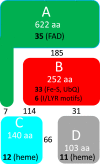Succinate dehydrogenase variants in paraganglioma: why are B subunit variants 'bad'?
- PMID: 37434649
- PMCID: PMC10305465
- DOI: 10.1530/EO-22-0093
Succinate dehydrogenase variants in paraganglioma: why are B subunit variants 'bad'?
Abstract
Mutations that predispose to familial pheochromocytoma and paraganglioma include inherited variants in the four genes (SDHA, SDHB, SDHC and SDHD) encoding subunits of succinate dehydrogenase (SDH), an enzyme of the mitochondrial tricarboxylic acid cycle and complex II of the electron transport chain. In heterozygous variant carriers, somatic loss of heterozygosity is thought to result in tumorigenic accumulation of succinate and reactive oxygen species. Inexplicably, variants affecting the SDHB subunit predict worse clinical outcomes. Why? Here we consider two hypotheses. First, relative to SDH A, C and D subunits, the small SDHB subunit might be more intrinsically 'fragile' to missense mutations because of its relatively large fraction of amino acids contacting prosthetic groups and other SDH subunits. We show evidence that supports this hypothesis. Second, the natural pool of human SDHB variants might, by chance, be biased toward severe truncating variants and missense variants causing more disruptive amino acid substitutions. We tested this hypothesis by creating a database of known SDH variants and predicting their biochemical severities. Our data suggest that natural SDHB variants are more pathogenic. It is unclear if this bias is sufficient to explain clinical data. Other explanations include the possibility that SDH subcomplexes remaining after SDHB loss have unique tumorigenic gain-of-function characteristics, and/or that SDHB may have additional unknown tumor-suppressor functions.
Keywords: missense variant; paraganglioma; pathogenicity; pheochromocytoma; succinate dehydrogenase.
© the author(s).
Conflict of interest statement
The authors believe that there is no conflict of interest that could be perceived as prejudicing the impartiality of the research reported.
Figures


References
-
- Andrews KA, Ascher DB, Pires DEV, Barnes DR, Vialard L, Casey RT, Bradshaw N, Adlard J, Aylwin S, Brennan P, et al. 2018Tumour risks and genotype-phenotype correlations associated with germline variants in succinate dehydrogenase subunit genes SDHB, SDHC and SDHD. Journal of Medical Genetics 55384–394. ( 10.1136/jmedgenet-2017-105127) - DOI - PMC - PubMed
-
- Bayley JP, Bausch B, Rijken JA, Van Hulsteijn LT, Jansen JC, Ascher D, Pires DEV, Hes FJ, Hensen EF, Corssmit EPM, et al. 2020Variant type is associated with disease characteristics in SDHB, SDHC and SDHD-linked phaeochromocytoma-paraganglioma. Journal of Medical Genetics 5796–103. ( 10.1136/jmedgenet-2019-106214) - DOI - PubMed
LinkOut - more resources
Full Text Sources
Research Materials
Miscellaneous
